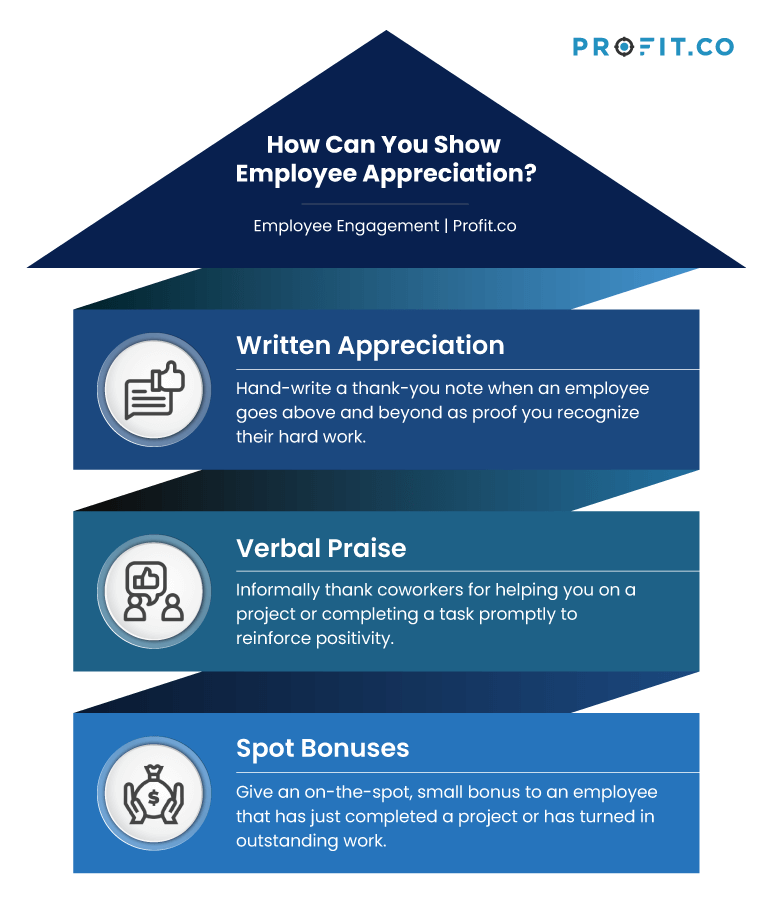What is employee recognition?
Employee Recognition Definition: Employee recognition occurs when managers and leaders openly acknowledge employees’ contributions and appreciate them for it. Recognition can take many forms, and is a vital component of a business’s success. An organization needs to choose the right form of recognition program, as it is a key factor that drives employee engagement within the workplace and it boosts productivity and employee retention.
People work for money but go the extra mile for recognition, praise and rewards.
Why is Employee Recognition Important?
An employee recognition program that is thought through and well implemented can work wonders for a business. It can positively impact engagement, performance, productivity, morale, motivation, and purpose. When engaged employees are recognized for their contributions, their engagement levels go up even more.
Employee recognition is key. If the organization takes its employees for granted and does not show appreciation for their contributions, they will never give it their all. Therefore, employee recognition spells success. Let’s take a look at why employee recognition is important:
Five benefits of employee recognition
- Encourages excellence
- Improves engagement
- Creates a sense of shared purpose
- Trust and Profitability go hand in hand
- Employee recognition program delivers unbiased performance data

1. Encourages excellence
Employee recognition encourages appreciating and empowering employees, which helps strengthen relationships and gives employees purpose and meaning. All of this, in turn, creates a culture of excellence, where every member of the team strives to do better, and take the company to greater heights.
2. Improves engagement
Employee recognition positively impacts engagement. It impacts it even more when already engaged employees are given recognition. Awards and recognition can go a long way to help employees feel they are appreciated for their contributions.
3. Creates a sense of shared purpose
When employees are recognized for their efforts and contributions, there is a sense of gratitude and commitment that they feel towards the company, which brings about a shared sense of purpose among the workforce. This shared sense of purpose, values, and ideals that they share with each other and the company as a whole, gets deeply etched into their actions and thoughts which sets the organization on the path to success.
4. Trust and Profitability go hand in hand
With commitment comes trust. When there’s trust in the organization, profitability will follow. Employees who trust the management and their leaders are more likely to love their jobs and be engaged, thus implying that trust in the organization and profitability are closely linked. Employers can build trust through staff appreciation, which can help employees feel more satisfied in their role and perform better.
5. Employee recognition programs deliver unbiased performance data
An employee recognition program delivers unbiased, genuine performance data that can help management identify the top performers and also give an insight into the company culture and how the employees bond or connect with each other.
What is the best way to recognize employees?

Depending on the nature of the organization, employee recognition and rewards will vary. Employee recognition and rewards vary depending on the nature of the organization. It’s on the organization to find the most meaningful way of appreciating its employees depending on its unique needs and on the needs of its employees.

1. Written appreciation
Sounds simple, but writing a thank you note can go a long way in showing appreciation for an employee’s contribution. It’s very uplifting to get a note of thanks, whether it is sent as an email, or handwritten. It is proof of the employee’s contributions.
2. Verbal praise
Verbal praise is a peer-to-peer form of recognition, given by co-workers, appreciating a team member’s contributions at work. Although informal, and not written, it is still part of an employee recognition program and can be very effective.
3. Spot bonuses
Spot bonuses are bonuses that are given on the spot — hence the name. They are small bonuses frequently given in recognition of a contribution. Spot bonuses have a huge impact, since it is given immediately, when the contribution has just been made; because ‘now’ is the best time to say thanks or show appreciation.
The other advantage of a spot bonus is that since they are small bonuses, anybody can give them, and doesn’t follow any level of hierarchy.
Following are a few employee recognition ideas that can work in your business.
10 Employee recognition ideas that work
There are plenty of employee recognition ideas. Some of them might sound very basic. But they can be very effective. Organizations need to thoughtfully tailor their ideas and make sure they are meaningful for their employees. Here are a few impactful ideas:
- A points-based rewards system
- Surveys to get employees’ feedback on recognition
- Publicly recognizing employee contributions
- Celebrate milestones
- Celebrate personal achievements
- Make employee recognition a part of company culture
- Send a note of thanks
- Encourage leaders to practice recognition
- Encourage peer-to-peer recognition
- Reward professional growth
1. A points-based rewards system
A point-based rewards system can help boost employee engagement. The way the system works is it allows the employee to accumulate points, and when the employee has accumulated enough points, he or she can redeem it for a reward that they want; not something that the organization has chosen for them that may or may not be useful to them. Collecting points also builds excitement and gives them the power to choose, thus encouraging them to scale new heights.
The points based system is an effective method to let employees know that their work is being noticed and that they are a valuable asset to the company.
2. Use surveys to get employees’ feedback on recognition
How the management sees the organization’s recognition efforts is often very different from how employees see it. For everyone to be on the same page, the management and the employees, an effective method would be to conduct surveys. Surveys will help the organization understand the employees’ perspective and how they would like to be recognized and rewarded. Surveys will also be very welcome as it’s a way of letting employees know that their opinions matter, so they would be more than willing to participate and give their feedback.
Tailor the recognition program to suit the needs of the employees. It would also be a good idea to test out the program with a select few employees before implementing it across the company, and then keep improvising upon it based on regular feedback.
3. Publicly recognizing employee contributions
Not only is publicly recognizing employee contributions a huge boost in morale and motivation for the said employee, but also acts as an inspiration and example for co-workers to emulate and creates an environment of positivity.
There are many ways of recognizing employees publicly. For example:
- A company-wide newsfeed gets the recognition across to all employees of the organization.
- Create a wall of fame
- An event to recognize achievements
- Email announcements
- Highlight employee contributions in meetings
These are just a few examples of how to acknowledge achievements and get maximum impact.
4. Celebrate milestones
Celebrate important milestones of an employee’s career. For example, a work anniversary, which demonstrates the employee’s loyalty towards the company. Definitely something worth celebrating and being rewarded for, as a token of appreciation. Give the employee the option to select a gift that they want. Make it more personalized and meaningful by adding a note from co-workers, managers, and the CEO to make it a milestone that’s memorable.
5. Celebrate personal achievements
Never lose sight of the fact that employees are more than just employees. They are individuals, so celebrate them for their personal achievements as well, on and off the job, some of which could be:
- Learning a new skill
- Collaboration with a teammate
- Hitting a target
- Hitting a health and wellness goal
These frequent appreciations, however little they might seem, go a long way in celebrating employees as individuals.
6. Make employee recognition a part of company culture
Employee recognition is the cornerstone of great company culture. It has a positive impact on the success of the company. When an organization fosters a positive workplace culture, it not only becomes popular with its employees and sees increased employee retention, but it also becomes popular with job seekers as well. As a result, it automatically becomes a much sought after place of work and attracts top talent. Following are some of things an organization can do to get started on building a culture of employee recognition:
3 tips to build a culture of employee recognition in your organization
- Make peer-to-peer, team, manager, and leadership recognition a frequent feature
- Identify certain positive behaviors that resonate with the company values, and tie recognition to those specific behaviors. Employees feel motivated to repeat those positive behaviors when they are recognized for it, and in turn, it shapes company culture.
- Social recognition is communicating appreciation to employees in writing or verbally. This is yet another way of making employee recognition part of company culture. Timing is of essence for social recognition — when an employee does something that is worthy of recognition, appreciation must be given then and there for it to be effective, not wait for the next internal meeting to highlight it. It is more effective and memorable when it is done in the moment, and more likely to be repeated too.
7. Send a note of thanks
A simple note of thanks speaks volumes. It can be very meaningful and it has a personal touch to it. It can be handwritten or digital. It’s a way of showing the employee that they matter, and the management and organization are thankful to them for their contribution. A few things to bear in mind while writing the note:
- Be specific about the contribution or effort
- Talk about how the contribution impacted the organization
- Sincerely express gratitude and acknowledge the efforts
8. Encourage leaders to practice recognition
When top management recognizes its employees’ efforts, it has a positive impact on their morale and productivity. Following are some recommendations for recognition:
- Set an example for their team by recognizing employees often
- Host meetings to publicly recognize the top performers
- Promote and advocate a culture of recognition company wide, in meetings with top management
- Learn what the best form of recognition is for the employees, whether it’s monetary or social.
- Make it easy for leaders to recognize their team members; e.g. one-click recognitions— let that be an option that they can have in case they are too busy for longer recognition processes.
When times are tough, recognition from leaders is very crucial. A positive outlook in those tough times, their support, and their acknowledgement can help keep things moving forward.
9. Encourage peer-to-peer recognition
Just as recognition from leadership is important, recognition from colleagues is also important. These are the people they work with, and recognition from them builds a sense of camaraderie, trust, belonging and well-being. It can boost employee performance and helps create a positive environment in the workplace. Here are some recommendations on how to do peer-to-peer recognition in the workplace:
- Make sure that all employees can participate in the employee recognition program whether they’re on-site, traveling or working remotely.
- Ensure all employees can participate in employee recognition celebrations, whether it’s an anniversary or personal achievement, colleagues should have the opportunity to comment and be a part of the event. This can also be done digitally where all team members can sign and customize the digital card with a special message of appreciation.
- Make it easy for colleagues to recognize their team members; e.g. one-click recognition
10. Reward professional growth
Performance excellence must be recognized. It is a way in which the organization can let their employees know that their contributions and exemplary work is being recognized. It encourages employees to stay with the company for the long term, leading to increased retention. Rewarding the employee does not always have to be in the form of a promotion — there are other ways to do this as well. For example, more autonomy, or more responsibilities. It’s a way of laying the trust in the employee.
If the employee achieves a new certification, present them with new business cards with their new certification credentials and present them a gift to let them know how proud the organization is of them. If an employee has met or crossed the target, give them an opportunity to attend a workshop or a conference.
Make sure they are recognized publicly company-wide— this helps others emulate these positive behaviors and also helps them see how serious the company is about employee recognition and how invested they are in the success of their employees.
In Conclusion
As seen above, there are many ways to implement employee recognition at the workplace. But at the very basic level, what’s important is the company culture; a company culture that believes in its employees and the importance of employee recognition. This is the cornerstone for a successful organization.
When working remotely, you can also use digital means of employee engagement and recognition. Engagement and award softwares such as Profit.co’s Employee Engagement module help keep employees engaged no matter where they are in the world or the workplace.
To see how Profit.co’s platform can help your organization, book a free demo today!

